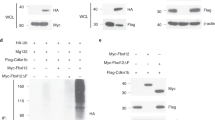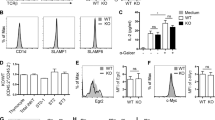Abstract
The influence of signals transmitted by the phosphatase calcineurin and the transcription factor NFAT on the development and function of natural killer T (NKT) cells is unclear. In this report, we demonstrate that the transcription factor early growth response 2 (Egr2), a target gene of NFAT, was specifically required for the ontogeny of NKT cells but not that of conventional CD4+ or CD8+ T cells. NKT cells developed normally in the absence of Egr1 or Egr3, which suggests that Egr2 is a specific regulator of NKT cell differentiation. We found that Egr2 was important in the selection, survival and maturation of NKT cells. Our findings emphasize the importance of the calcineurin-NFAT-Egr2 pathway in the development of the NKT lymphocyte lineage.
This is a preview of subscription content, access via your institution
Access options
Subscribe to this journal
Receive 12 print issues and online access
$209.00 per year
only $17.42 per issue
Buy this article
- Purchase on Springer Link
- Instant access to full article PDF
Prices may be subject to local taxes which are calculated during checkout





Similar content being viewed by others
References
Bendelac, A., Savage, P.B. & Teyton, L. The biology of NKT cells. Annu. Rev. Immunol. 25, 297–336 (2007).
Matsuda, J.L., Mallevaey, T., Scott-Browne, J. & Gapin, L. CD1d-restricted iNKT cells, the 'Swiss-Army knife' of the immune system. Curr. Opin. Immunol. 20, 358–368 (2008).
Vincent, M.S., Gumperz, J.E. & Brenner, M.B. Understanding the function of CD1-restricted T cells. Nat. Immunol. 4, 517–523 (2003).
Gapin, L., Matsuda, J.L., Surh, C.D. & Kronenberg, M. NKT cells derive from double-positive thymocytes that are positively selected by CD1d. Nat. Immunol. 2, 971–978 (2001).
Wei, D.G. et al. Expansion and long-range differentiation of the NKT cell lineage in mice expressing CD1d exclusively on cortical thymocytes. J. Exp. Med. 202, 239–248 (2005).
Benlagha, K., Kyin, T., Beavis, A., Teyton, L. & Bendelac, A. A thymic precursor to the NK T cell lineage. Science 296, 553–555 (2002).
Pellicci, D.G. et al. A natural killer T (NKT) cell developmental pathway involving a thymus-dependent NK1.1−CD4+ CD1d-dependent precursor stage. J. Exp. Med. 195, 835–844 (2002).
Alberola-Ila, J., Hogquist, K.A., Swan, K.A., Bevan, M.J. & Perlmutter, R.M. Positive and negative selection invoke distinct signaling pathways. J. Exp. Med. 184, 9–18 (1996).
Borowski, C. & Bendelac, A. Signaling for NKT cell development: the SAP-FynT connection. J. Exp. Med. 201, 833–836 (2005).
Chung, B., Aoukaty, A., Dutz, J., Terhorst, C. & Tan, R. Signaling lymphocytic activation molecule-associated protein controls NKT cell functions. J. Immunol. 174, 3153–3157 (2005).
Eberl, G., Lowin-Kropf, B. & MacDonald, H.R. Cutting edge: NKT cell development is selectively impaired in Fyn- deficient mice. J. Immunol. 163, 4091–4094 (1999).
Gadue, P., Morton, N. & Stein, P.L. The Src family tyrosine kinase Fyn regulates natural killer T cell development. J. Exp. Med. 190, 1189–1196 (1999).
Nichols, K.E. et al. Regulation of NKT cell development by SAP, the protein defective in XLP. Nat. Med. 11, 340–345 (2005).
Stanic, A.K. et al. Cutting edge: the ontogeny and function of Va14Ja18 natural T lymphocytes require signal processing by protein kinase C θ and NF-κB. J. Immunol. 172, 4667–4671 (2004).
Townsend, M.J. et al. T-bet regulates the terminal maturation and homeostasis of NK and Vα14i NKT cells. Immunity 20, 477–494 (2004).
Ohteki, T. et al. The transcription factor interferon regulatory factor 1 (IRF-1) is important during the maturation of natural killer 1.1+ T cell receptor-α/β+ (NK1+ T) cells, natural killer cells, and intestinal intraepithelial T cells. J. Exp. Med. 187, 967–972 (1998).
Sivakumar, V., Hammond, K.J., Howells, N., Pfeffer, K. & Weih, F. Differential requirement for Rel/nuclear factor κ B family members in natural killer T cell development. J. Exp. Med. 197, 1613–1621 (2003).
Macian, F. NFAT proteins: key regulators of T-cell development and function. Nat. Rev. Immunol. 5, 472–484 (2005).
Yoshida, H. et al. The transcription factor NF-ATc1 regulates lymphocyte proliferation and Th2 cytokine production. Immunity 8, 115–124 (1998).
Xanthoudakis, S. et al. An enhanced immune response in mice lacking the transcription factor NFAT1. Science 272, 892–895 (1996).
Ranger, A.M. et al. Delayed lymphoid repopulation with defects in IL-4-driven responses produced by inactivation of NF-ATc. Immunity 8, 125–134 (1998).
Oukka, M. et al. The transcription factor NFAT4 is involved in the generation and survival of T cells. Immunity 9, 295–304 (1998).
Hodge, M.R. et al. Hyperproliferation and dysregulation of IL-4 expression in NF-ATp-deficient mice. Immunity 4, 397–405 (1996).
Cante-Barrett, K., Winslow, M.M. & Crabtree, G.R. Selective role of NFATc3 in positive selection of thymocytes. J. Immunol. 179, 103–110 (2007).
Bueno, O.F., Brandt, E.B., Rothenberg, M.E. & Molkentin, J.D. Defective T cell development and function in calcineurin Aβ-deficient mice. Proc. Natl. Acad. Sci. USA 99, 9398–9403 (2002).
Neilson, J.R., Winslow, M.M., Hur, E.M. & Crabtree, G.R. Calcineurin B1 is essential for positive but not negative selection during thymocyte development. Immunity 20, 255–266 (2004).
Gallo, E.M. et al. Calcineurin sets the bandwidth for discrimination of signals during thymocyte development. Nature 450, 731–735 (2007).
Rengarajan, J. et al. Sequential involvement of NFAT and Egr transcription factors in FasL regulation. Immunity 12, 293–300 (2000).
Shao, H., Kono, D.H., Chen, L.Y., Rubin, E.M. & Kaye, J. Induction of the early growth response (Egr) family of transcription factors during thymic selection. J. Exp. Med. 185, 731–744 (1997).
Carleton, M. et al. Early growth response transcription factors are required for development of CD4−CD8− thymocytes to the CD4+CD8+ stage. J. Immunol. 168, 1649–1658 (2002).
Koltsova, E.K. et al. Early growth response 1 and NF-ATc1 act in concert to promote thymocyte development beyond the β-selection checkpoint. J. Immunol. 179, 4694–4703 (2007).
Miyazaki, T. Two distinct steps during thymocyte maturation from CD4−CD8− to CD4+CD8+ distinguished in the early growth response (Egr)-1 transgenic mice with a recombinase-activating gene-deficient background. J. Exp. Med. 186, 877–885 (1997).
Miyazaki, T. & Lemonnier, F.A. Modulation of thymic selection by expression of an immediate-early gene, early growth response 1 (Egr-1). J. Exp. Med. 188, 715–723 (1998).
Bettini, M., Xi, H., Milbrandt, J. & Kersh, G.J. Thymocyte development in early growth response gene 1-deficient mice. J. Immunol. 169, 1713–1720 (2002).
Carter, J.H., Lefebvre, J.M., Wiest, D.L. & Tourtellotte, W.G. Redundant role for early growth response transcriptional regulators in thymocyte differentiation and survival. J. Immunol. 178, 6796–6805 (2007).
Swiatek, P.J. & Gridley, T. Perinatal lethality and defects in hindbrain development in mice homozygous for a targeted mutation of the zinc finger gene Krox20. Genes Dev. 7, 2071–2084 (1993).
Benlagha, K., Wei, D.G., Veiga, J., Teyton, L. & Bendelac, A. Characterization of the early stages of thymic NKT cell development. J. Exp. Med. 202, 485–492 (2005).
Godfrey, D.I. & Berzins, S.P. Control points in NKT-cell development. Nat. Rev. Immunol. 7, 505–518 (2007).
Safford, M. et al. Egr-2 and Egr-3 are negative regulators of T cell activation. Nat. Immunol. 6, 472–480 (2005).
Carter, J.H. & Tourtellotte, W.G. Early growth response transcriptional regulators are dispensable for macrophage differentiation. J. Immunol. 178, 3038–3047 (2007).
Nguyen, H.Q., Hoffman-Liebermann, B. & Liebermann, D.A. The zinc finger transcription factor Egr-1 is essential for and restricts differentiation along the macrophage lineage. Cell 72, 197–209 (1993).
Krishnaraju, K., Hoffman, B. & Liebermann, D.A. Early growth response gene 1 stimulates development of hematopoietic progenitor cells along the macrophage lineage at the expense of the granulocyte and erythroid lineages. Blood 97, 1298–1305 (2001).
Krishnaraju, K., Nguyen, H.Q., Liebermann, D.A. & Hoffman, B. The zinc finger transcription factor Egr-1 potentiates macrophage differentiation of hematopoietic cells. Mol. Cell. Biol. 15, 5499–5507 (1995).
Lee, S.L., Tourtellotte, L.C., Wesselschmidt, R.L. & Milbrandt, J. Growth and differentiation proceeds normally in cells deficient in the immediate early gene NGFI-A. J. Biol. Chem. 270, 9971–9977 (1995).
Laslo, P. et al. Multilineage transcriptional priming and determination of alternate hematopoietic cell fates. Cell 126, 755–766 (2006).
Brigl, M., Bry, L., Kent, S.C., Gumperz, J.E. & Brenner, M.B. Mechanism of CD1d-restricted natural killer T cell activation during microbial infection. Nat. Immunol. 4, 1230–1237 (2003).
Zullo, A.J., Benlagha, K., Bendelac, A. & Taparowsky, E.J. Sensitivity of NK1.1-negative NKT cells to transgenic BATF defines a role for activator protein-1 in the expansion and maturation of immature NKT cells in the thymus. J. Immunol. 178, 58–66 (2007).
Acknowledgements
We thank D. Kozoriz for cell sorting; the National Institutes of Health Tetramer Core Facility at Emory University for unloaded and PBS57-loaded CD1d tetramers; J. Milbrandt (Washington University) for Egr2+/− and Egr3−/− mice; and M. Brenner (Harvard Medical School) and M. Brigl (Harvard Medical School) for the human NKT cell clone BM2a.3. Supported by the National Institutes of Health (PONS038037 and UOAI31541 to L.H.G.) and the Cancer Research Institute (V.L.)
Author information
Authors and Affiliations
Contributions
V.L. designed and did experiments and prepared the manuscript; A.J.Z. and T.L.S. contributed to discussions, experimental design and manuscript preparation; A.J.Z. and M.N.S. provided technical assistance; L.H.G. supervised the work and the manuscript preparation; and G.R.C. and E.M.G. provided Cnb1fl/fl Lck-Cre+ mice.
Corresponding author
Ethics declarations
Competing interests
L.H.G. is on the board of directors and holds equity in Bristol Myers Squibb.
Supplementary information
Supplementary Text and Figures
Supplementary Figures 1–6, Table 1 and Supplementary Methods (PDF 3074 kb)
Rights and permissions
About this article
Cite this article
Lazarevic, V., Zullo, A., Schweitzer, M. et al. The gene encoding early growth response 2, a target of the transcription factor NFAT, is required for the development and maturation of natural killer T cells. Nat Immunol 10, 306–313 (2009). https://doi.org/10.1038/ni.1696
Received:
Accepted:
Published:
Issue Date:
DOI: https://doi.org/10.1038/ni.1696
This article is cited by
-
Invariant natural killer T cells in lung diseases
Experimental & Molecular Medicine (2023)
-
Integrative scATAC-seq and scRNA-seq analyses map thymic iNKT cell development and identify Cbfβ for its commitment
Cell Discovery (2023)
-
Markers and makers of NKT17 cells
Experimental & Molecular Medicine (2023)
-
Current Developments in the Preclinical and Clinical use of Natural Killer T cells
BioDrugs (2023)
-
Transcription factor EGR2 controls homing and pathogenicity of TH17 cells in the central nervous system
Nature Immunology (2023)



